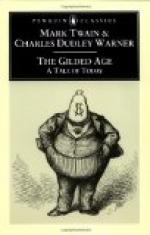“I don’t know, father. Sometimes I think I’ll have a balloon and go up in the air; and sometimes I think I’ll have ever so many books; and sometimes I think I’ll have ever so many weathercocks and water-wheels; or have a machine like that one you and Colonel Sellers bought; and sometimes I think I’ll have—well, somehow I don’t know—somehow I ain’t certain; maybe I’ll get a steamboat first.”
“The same old chap!—always just a little bit divided about things.—And what will you do when you get to be one of the richest men in the world, Clay?”
“I don’t know, sir. My mother—my other mother that’s gone away—she always told me to work along and not be much expecting to get rich, and then I wouldn’t be disappointed if I didn’t get rich. And so I reckon it’s better for me to wait till I get rich, and then by that time maybe I’ll know what I’ll want—but I don’t now, sir.”
“Careful old head!—Governor Henry Clay Hawkins!—that’s what you’ll be, Clay, one of these days. Wise old head! weighty old head! Go on, now, and play—all of you. It’s a prime lot, Nancy; as the Obedstown folk say about their hogs.”
A smaller steamboat received the Hawkinses and their fortunes, and bore them a hundred and thirty miles still higher up the Mississippi, and landed them at a little tumble-down village on the Missouri shore in the twilight of a mellow October day.
The next morning they harnessed up their team and for two days they wended slowly into the interior through almost roadless and uninhabited forest solitudes. And when for the last time they pitched their tents, metaphorically speaking, it was at the goal of their hopes, their new home.
By the muddy roadside stood a new log cabin, one story high—the store; clustered in the neighborhood were ten or twelve more cabins, some new, some old.
In the sad light of the departing day the place looked homeless enough. Two or three coatless young men sat in front of the store on a dry-goods box, and whittled it with their knives, kicked it with their vast boots, and shot tobacco-juice at various marks. Several ragged negroes leaned comfortably against the posts of the awning and contemplated the arrival of the wayfarers with lazy curiosity. All these people presently managed to drag themselves to the vicinity of the Hawkins’ wagon, and there they took up permanent positions, hands in pockets and resting on one leg; and thus anchored they proceeded to look and enjoy. Vagrant dogs came wagging around and making inquiries of Hawkins’s dog, which were not satisfactory and they made war on him in concert. This would have interested the citizens but it was too many on one to amount to anything as a fight, and so they commanded the peace and the foreign dog coiled his tail and took sanctuary under the wagon. Slatternly negro girls and women slouched along with pails deftly balanced on their heads, and joined the group and stared. Little half dressed white boys,




